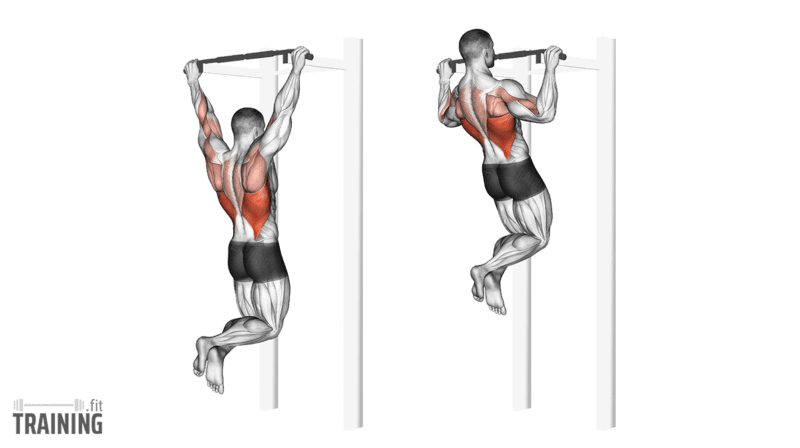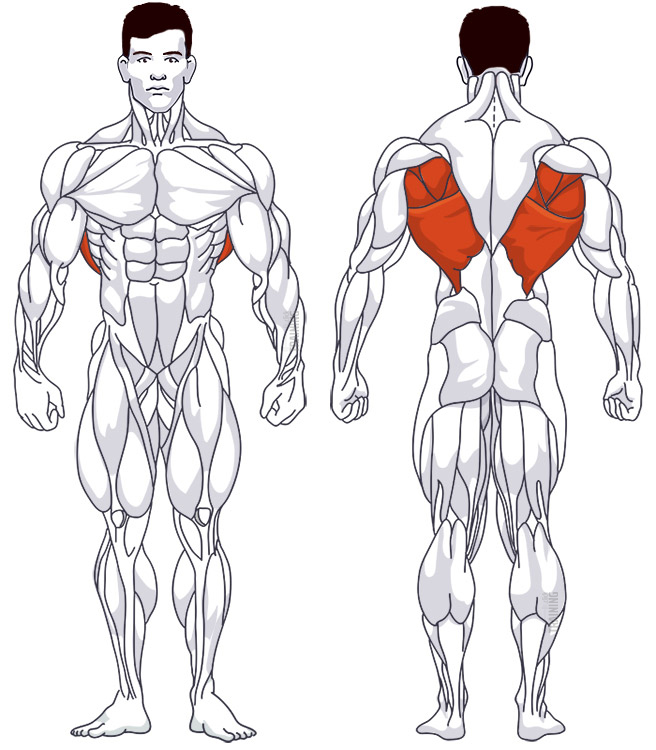Wide Grip Pull-Ups
Compound exercise, Body weightThis article is verified by 2 studies/publications.
Overview

Main muscles
- Back: Large round muscle
(Musculus teres major) - Back: Large back muscle
(Musculus latissimus dorsi) - Back: Larger rhomboid muscle
(Musculus rhomboideus major) - Back: Small round muscle
(Musculus teres minor)
Training plans
Wide Grip Pull-Ups is a suitable substitute for similar exercises in upper back training or as a supplement to various training plans.
Wide Grip Pull-Ups: Basics and alternatives

Involved main muscle groups:
Wide Grip Pull-Ups
Wide grip pull-ups are a popular variation of the classic fitness exercise. The movement remains the same: hang from a pull-up bar and pull your body upwards until your chin reaches the bar.
The goal of the wide grip is to reduce biceps activation and put more stress on the lat muscles. However, the greater strain on the rotator cuff is a significant disadvantage of this grip width. The movement can potentially cause or worsen impingement syndrome, leading to shoulder pain and mobility issues[1].
Moreover, the wide grip doesn’t necessarily provide higher muscle activation. A study showed that lat activation is barely different with a grip slightly wider than shoulder-width[2].
It’s generally not recommended to perform this exercise; instead, opt for a normal grip width pull-up (slightly wider than shoulder width).
Correct execution
If you still want to perform wide-grip pull-ups, despite the potential injury risks, focus on proper execution. Avoid swinging your legs or body for support, as this could increase stress on your shoulders.
Video tutorial
Step-by-step instructions
Stand under the pull-up handles or bar and grab it with an overhand grip.
Bend your legs slightly and hang from the handles or bar.
Engage your shoulder blades.
Pull your body upwards using your arms and back muscles until your chin reaches the level of your hands.
Lower your body back to the hanging position slowly and in a controlled manner.
Common mistakes and injuries
With wide grip pull-ups, it’s essential to maintain a clean execution without swinging. Equally important is to lower your body in a controlled manner rather than dropping, as this increases stress and injury risk.
If you’ve experienced shoulder pain in the past or currently have it, avoid this exercise altogether. Perform your back workout with regular grip pull-ups (slightly wider than shoulder width) or switch to another exercise for the upper back instead.
Sources
- Scapula kinematics of pull-up techniques: Avoiding impingement risk with training changes. Joe A.I. Prinold, Anthony M.J. Bull. J Sci Med Sport. 2016 Aug; 19(8): 629-635. doi: 10.1016/j.jsams.2015.08.002. URL: https://www.ncbi.nlm.nih.gov/pmc/articles/PMC4916995/, accessed 2020-08-16.
- Comparison of Loading and Muscle Activity in Lat Pull-Down. Andersen, V., Fimland, M. S., Wiik, E., Skoglund, A., & Saeterbakken, A. H. Journal of Strength and Conditioning Research, 28(4), 1135-1142. doi: 10.1097/jsc.0000000000000232. URL: https://pubmed.ncbi.nlm.nih.gov/24662157/, accessed 2020-08-16.